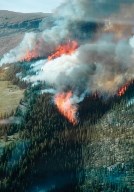Environment and Sustainable Resource Development (ESRD) officials have completed a prescribed fire in West Central Alberta that has been planned for six years.
The two-day prescribed fire covered approximately 100 hectares in the upper Clearwater area, located approximately 75 kilometres west of Sundre.
The fire met all of the goals that ESRD officials were aiming for, said Whitney Exton, information officer with ESRD.
“They initially started looking at it about six years ago and put together a plan and then they had to wait for the right opportunity and the right day to start operations,” said Exton.
The prescribed fire began on May 11, where approximately 60 hectares were burned. Forty hectares were burned the following day, which completed the fire.
The conditions are extremely specific for ESRD officials to go through with a prescribed fire, she said.
The outside temperature, the wind and the amount of snow on the ground are all factors that affect how the fire will burn.
“Four hundred and sixty-seven hectares is the total area, so what they'll do is start burning and then assess the situation as it keeps going,” she said.
One of the main goals of the prescribed fire was to decrease the overall forest age.
“Trees start shading the undergrowth so there is not a lot of vegetation that can grow on the forest floor and then because of that it starts pushing out the grazers,” she said.
“Animals like deer and elk and bears start moving away from the area because they don't have any more foraging opportunities.”
There was a potential threat of wildfire in the area because the forest floor was covered in dead branches and vegetation, otherwise known as wildfire fuel.
The prescribed fire removed the old trees and cleared out all of the wildfire fuel.
This also makes room for new growth and new species in the area, she said.
“What happens with prescribed fires is when they start setting the fire and they start the operations, they'll let the fire burn to mimic natural wildfire,” she said.
“The fire doesn't always burn everything in its path; there can be pockets of trees and land that aren't burned.”
After the prescribed fire burns the area, the forest naturally rebuilds itself.
“Plants and trees start growing almost immediately within the area,” she said, adding that there are species such as morel mushrooms that only grow in areas where fire has gone through.
Firefighters on scene of the prescribed burn started the fire at the top of the hill that was targeted in the area and worked their way down, as fire moves uphill.
They used a “helitorch” that dropped a flammable gel substance into the area.
“The torch will spit out a flame and the helicopter pilot has a trigger and he presses the trigger and it lets the gel drop out in little bits at a time,” she said.
“The gel falls through the torch flame, and then the fire coats the gel and then when the gel falls it lands on trees or shrubs and then it coats that area and burns it.”
The gel-like substance is created from mixing flammable fluids together, she said.
“It lets the fire managers get into areas that are at higher elevation and harder to access by foot and they can cover larger areas that way,” she said.
Another primary method of performing prescribed fires is with ground crews, where firefighters use hand-torches with the same kind of gel.
Sometimes the crew uses machines to clear the area, remove trees and vegetation and will use a water hose and sprinkler lines that create secure containment lines, she said.
Before firefighters began the prescribed fire, hours of preparation took place and the 467-hectare area was blocked off.
Crew members searched the area numerous times to confirm that no one was in the area and circled the area with a helicopter to scare off wildlife.
Wildlife in the area leave because of the noise of the helicopter and if they don't, then they will leave as soon as they smell smoke, she said.
Dave Finn, incident commander of the prescribed fire, said aerial ignition is dangerous, which is one of the reasons why the conditions are very specific.
The helicopter using the helitorch was flying at treetop level so that the gel would land where intended.
“The reality of a wildfire is it may be huge if it's in hazard conditions,” said Finn.
The best time to perform a prescribed fire is early spring because there is still snow on the ground, he said.
“That gives us a lot of security,” he said.



